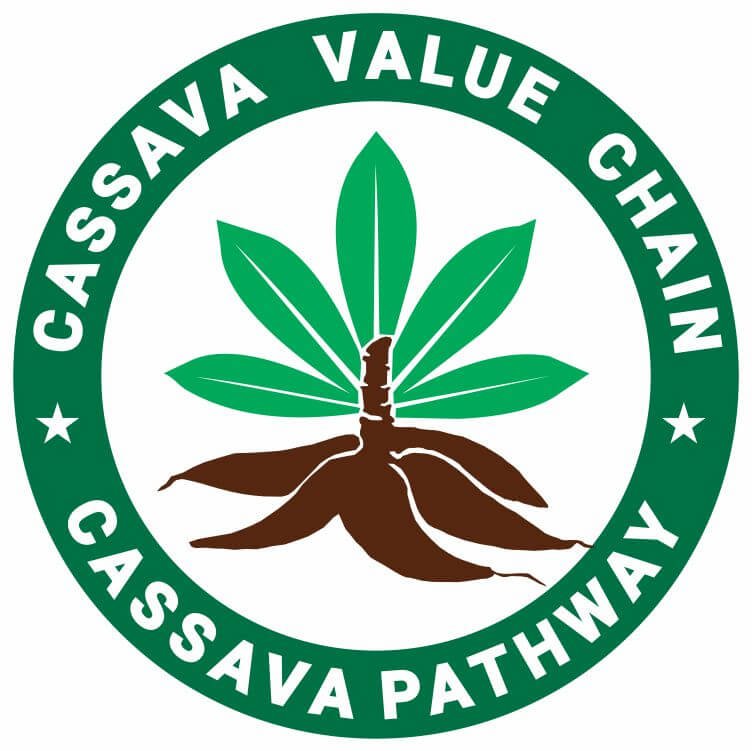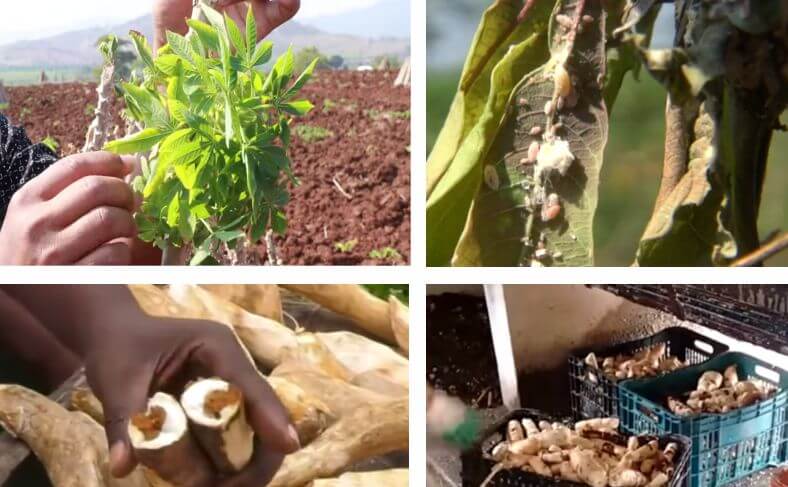From cultivation to processing to distribution, various factors can impact the efficiency and profitability of the cassava value chain.
The cassava industry provides food and income for millions, but challenges at every stage make it hard to maximize its potential.
Post-harvest losses occur because cassava spoils quickly.
Without proper storage or efficient transportation, large portions of the harvest go to waste, cutting into profits. Processing remains another hurdle.
Many farmers lack modern equipment, making it difficult to produce high-quality flour, starch, or ethanol.
Limited market access leads to unstable prices and unsold harvests, forcing many to sell at a loss.
Pests and diseases like cassava mosaic disease and brown streak disease destroy crops, reducing yields and incomes.
High input costs, poor infrastructure, weak cooperatives, and a lack of research further slow progress.
Addressing these issues requires better storage, stronger market connections, pest management, and access to credit. What do you think is the biggest challenge?
Recommended: Cassava, the Super Crop
Table of Contents
- Challenges Facing the Cassava Value Chain and How to Tackle Them
- How to Tackle the Challenges of the Cassava Value Chain and Industry
- Frequently Asked Questions
- Final Word from Cassava Pathway
Challenges Facing the Cassava Value Chain and How to Tackle Them
1. Post-Harvest Losses: A Major Setback
Cassava spoils fast after harvest, creating major losses for farmers. Once pulled from the ground, its high moisture content triggers rapid deterioration, forcing farmers to sell quickly, often at low prices.
Without proper storage, cassava roots rot within days, reducing both quality and marketability.
Limited access to storage facilities makes this worse. Most farmers lack cooling systems or drying methods to extend shelf life. Microbial contamination and enzymatic breakdown further accelerate spoilage.
Poor transportation networks add to the problem, making it difficult to move cassava to buyers or processing centers before it goes bad.
2. Pest and Disease Control
One of the primary challenges facing cassava farming is the control of pests and diseases.
Cassava is susceptible to several diseases, including mosaic disease, cassava bacterial blight, and anthracnose disease, which can significantly reduce yields and quality.
Also, pests like cassava mealybugs and green spider mites can infest cassava plantations, causing damages that can lead to a 100% loss in yields.
Effective pest and disease management strategies are necessary to ensure the sustainability of cassava production.
3. Input Challenges: Access to Quality Planting Materials
Cassava farmers face significant challenges in accessing essential agricultural inputs, affecting their productivity and profitability.
Quality seeds, fertilizers, and pesticides are often expensive and difficult to obtain, limiting farmers’ ability to maximize yields.
Without access to improved planting materials, many rely on low-yield varieties, reducing efficiency.
Additionally, inadequate distribution networks make it harder for rural farmers to acquire necessary inputs.
This lack of resources leads to lower cassava quality and market competitiveness.
Addressing these input challenges is critical for strengthening the cassava value chain, as reliable access to inputs directly influences productivity and overall industry sustainability.
4. Environmental Challenges
The cassava value chain faces several environmental challenges that threaten production and sustainability.
Climate variability, including erratic rainfall and rising temperatures, directly affects cassava yields, reducing both quality and quantity.
Drought, in particular, weakens plant growth and increases crop failure risks. Additionally, unsustainable farming practices contribute to soil degradation, deforestation, and biodiversity loss.
Poor land management accelerates erosion and nutrient depletion, further lowering productivity.
These environmental issues create a cycle of declining yields and economic instability for farmers.
Without sustainable interventions, the cassava industry risks long-term decline, making it crucial to adopt environmentally friendly practices that enhance resilience.
Related: Cassava Farming Best Practices
5. Market Access and Price
Market access and price is another challenge facing cassava farmers and the cassava value chain.
Small farmers often struggle to access and understand the market dynamics, and face price fluctuations due to not enough information about demands, prices, and what consumers really want.
They rely on middlemen who are out for themselves which can lead to unfair pricing and not enough profit margins.
This can be discouraging, causing a slack or laidback attitude on the side of farmers.
Improving market access and providing farmers with better information about market conditions can help them negotiate better prices and increase their income, thereby encouraging them to seek more opportunities in the cassava value chain.
Related: Cassava Farm Weed Management
6. Storage and Transportation of Harvest
Another challenge in the cassava value chain is the storage and transportation of harvested cassava roots.
Lack of access and inadequate warehousing and transportation facilities can force farmers to sell their harvest at low prices, causing dissatisfaction and discouragement, which in turn impacts both quality and quantity.
Developing stable electricity and improving transportation infrastructure can help farmers secure fair prices for their products.
7. Information Flow and Transparency
The flow of transparent information in the cassava value chain is often unclear and unstable, with communication mostly occurring from the demand side to the supply side to their advantage.
This arrangement puts the farmers who are on the most important side of the cassava value chain in a precarious situation, often having no say, only at the mercy of the marketers.
This lack of transparency can lead to poor understanding of cross-border trades and unfair pricing.
When farmers are in the information loop and know that they are the most important in the cassava value chain, they participate more in the information flow, know their place in the chain, and can negotiate better prices.
This gives them a sense of belonging, transparency, and encouragement to put more effort into cassava production.
Related: How Cassava Farming Affects the Environment
8. Technology and Infrastructure: Limited Processing Facilities
One of the biggest challenges facing the cassava value chain is the lack of infrastructure and technology in many cassava-producing regions.
In my community, everything is done traditionally, from planting and harvesting to processing and selling.
There is no automation or modern technology. Farmers grow cassava mainly for garri, fufu (akpu), and cassava chips for puddings, and that’s where it ends.
The starch, one of cassava’s most valuable byproducts, is completely wasted during garri and fufu production because people don’t realize its potential.
Poor roads, inadequate storage, and a lack of proper processing facilities make it even harder for farmers to get their products to market.
Without efficient logistics, cassava roots spoil quickly, leading to post-harvest losses and lower earnings.
Processing cassava into flour, starch, or ethanol requires advanced equipment, but most processors still rely on outdated methods.
This limits production capacity and quality, making it difficult to meet industry standards or compete in larger markets.
Farmers end up with low returns, discouraging further investment in cassava farming.
9. Financing Challenges in the Cassava Industry
Financing remains a major barrier in the cassava value chain, preventing farmers and processors from scaling their operations.
Many small-scale producers cannot afford modern machinery, quality planting materials, or efficient storage solutions.
Limited access to credit forces them to rely on outdated methods that slow productivity and reduce product quality.
Even when loans exist, high interest rates and stringent conditions make borrowing difficult. Many farmers lack financial literacy or awareness of available grants, cooperative loans, and government subsidies.
Corruption and bureaucratic delays further complicate the process, leaving funds out of reach.
Improving access to affordable credit and government-backed financing can change this. With better funding, farmers and processors can invest in technology, infrastructure, and logistics, boosting cassava’s profitability and market competitiveness.
10. Deforestation and Soil Degradation
Deforestation and soil degradation are major concerns for the cassava value chain.
Expanding cassava plantations often leads to forest loss, reducing biodiversity and soil fertility.
Intensive farming without proper land management results in erosion, nutrient runoff, and declining productivity.
As topsoil depletes, cassava yields drop, forcing farmers to clear new land, perpetuating environmental damage.
Water pollution from chemical runoff further worsens the ecosystem’s health.
To mitigate these effects, adopting agroforestry, crop rotation, and erosion control measures is essential.
Sustainable land use strategies can help balance agricultural productivity with environmental conservation, ensuring the cassava industry’s long-term viability.
11. Sustainability Challenges
The cassava value chain faces sustainability challenges that include cassava pests and diseases, deforestation, soil degradation, and water pollution.
These pose threats to cassava production in many cassava-producing regions because most local smallholder farmers can’t do anything to help it.
This is where the government has a big role to play.
There are also social concerns related to labor practices and land tenure rights.
Addressing these challenges requires a multi-stakeholder approach involving farmers, governments, industry, and development organizations.
Investments in infrastructure, technology, and extension services can improve productivity and efficiency.
Initiatives to improve market access, financial inclusion, and sustainability practices can help ensure a more resilient and sustainable cassava value chain.
How to Tackle the Challenges of the Cassava Value Chain and Industry
Sustainable Farming Practices in Cassava Cultivation
Cassava farming comes with environmental challenges, but you can adopt sustainable methods to improve soil health and productivity.
Agroforestry, intercropping, and conservation tillage help maintain soil fertility and reduce deforestation.
Switching to organic fertilizers and drought-resistant cassava varieties strengthens resilience against climate change.
Efficient irrigation and water conservation techniques allow you to manage unpredictable rainfall.
Educating farmers on sustainable agriculture is key. Governments, research institutions, and farmer cooperatives must collaborate to promote eco-friendly techniques.
By focusing on sustainability, you not only increase yields but also protect the environment for future generations.
Overcoming Financial Barriers and Access to Inputs
As mentioned earlier, limited financial resources make it hard for small-scale farmers to buy essential inputs like fertilizers and pest control solutions.
High input prices and fluctuating market rates add uncertainty to farm budgeting.
Access to agricultural credit is another challenge, with high interest rates making loans unfeasible for many farmers.
To break this cycle, financial support systems need improvement.
Expanding subsidies, input credit schemes, and low-interest loans can help farmers afford quality seeds and fertilizers.
Strengthening cooperatives can also reduce costs through bulk purchasing.
By improving financial accessibility, you can enhance cassava productivity and build a stronger value chain.
Strengthening Farmer Support Systems
Lack of access to affordable, high-quality inputs limits cassava production.
Governments can address this by subsidizing seeds and fertilizers, while cooperatives can negotiate better deals for farmers.
Training programs on efficient resource use and organic alternatives provide practical solutions to input shortages.
Public-private partnerships can improve supply chains, making agricultural inputs more accessible.
When you have the right resources at the right price, cassava farming becomes more profitable and sustainable.
Increasing Transparency in the Cassava Value Chain
A lack of transparency keeps small-scale farmers at a disadvantage. Without access to real-time market information, you might fall victim to price fluctuations and unfair trading practices.
Middlemen often manipulate prices, reducing farmer profits and distorting the true value of cassava.
Inconsistent grading standards further complicate fair pricing.
Digital market platforms and standardized pricing structures can change this.
Access to transparent market data empowers farmers to make informed financial decisions.
When buyers and sellers operate on fair terms, the cassava industry becomes more equitable and efficient.
Addressing Market Manipulation
Intermediaries control much of the cassava trade, leading to unfair pricing. Without direct market access, many farmers sell at a loss.
The absence of standardized pricing means buyers set prices arbitrarily, further limiting profit potential.
By forming cooperatives, farmers can sell in bulk at competitive rates.
Mobile-based market information systems give you real-time updates on pricing trends, helping you negotiate better deals.
Regulatory policies on fair trade and direct farmer-to-market platforms can further curb exploitation.
When farmers receive fair compensation, cassava production becomes a viable and profitable business.
Implementing Industry Standards and Fair Trade Policies
The cassava industry needs clear grading standards and stronger market regulations.
Standardized quality benchmarks ensure fair pricing and reward high-quality produce.
Governments should enforce fair trade policies to prevent exploitation by middlemen.
Digital platforms can connect farmers directly with buyers, reducing reliance on intermediaries.
Financial literacy programs help you understand market trends and negotiate better deals.
A transparent value chain encourages investment and boosts overall industry growth.
Advancing Cassava Research and Innovation
Research plays a critical role in improving cassava farming. High-yield, disease-resistant varieties can increase production and minimize losses.
Climate-adaptive strains reduce the impact of pests and environmental stress.
However, limited funding often slows research progress, and many discoveries never reach farmers.
Investing in cassava research bridges this gap. When researchers work directly with farmers, new innovations become practical solutions.
Government and private sector funding can support breeding programs, biofortification, and precision farming technologies.
By integrating research into everyday farming, you can improve yields and long-term sustainability.
Strengthening Research Collaboration
Collaboration between farmers, researchers, and policymakers drives industry innovation.
Many breakthroughs in cassava farming remain underutilized due to weak communication channels.
Strengthening partnerships can improve the adoption of new technologies.
Encouraging knowledge-sharing programs and on-field demonstrations helps farmers embrace modern techniques.
Governments should prioritize agricultural research funding and create incentives for private investment.
By closing the gap between research and practice, cassava farming can become more efficient and profitable.
Addressing Policy and Regulatory Barriers
Inconsistent policies create obstacles for cassava farmers. Lack of clarity on subsidies, land use, and market access makes it harder to plan long-term.
Regional regulatory differences further complicate the industry, leading to inefficiencies and market instability.
Governments must streamline policies to support cassava farming. Simplifying access to financial aid, improved seeds, and infrastructure can strengthen production.
Regulatory bodies should also monitor market transparency to prevent price manipulation and ensure fair competition.
When policies work in favor of farmers, the cassava industry thrives.
Improving Policy Implementation
Many agricultural policies exist but lack enforcement. Farmers struggle with bureaucratic red tape, limiting their ability to access essential resources.
Governments should create farmer-friendly policies with clear guidelines on funding, land use, and input subsidies.
Stronger enforcement of market regulations ensures fair pricing and reduces exploitation.
Encouraging farmer participation in policy discussions can lead to more practical regulations.
When policies align with farmers’ needs, cassava production can scale efficiently, driving food security and economic growth.
Frequently Asked Questions
1. What are the major challenges in cassava production?
Pests and diseases, low yields, lack of improved varieties, poor soil fertility, and inadequate processing facilities are major challenges in cassava production.
2. How can cassava storage life be extended?
Proper harvesting techniques, waxing, and storage in cool, dry conditions can extend cassava storage life. Proper processing into flour or chips also helps.
3. What are the challenges in cassava processing?
Inadequate processing equipment, high energy costs, low-capacity utilization, and lack of skilled personnel are major challenges in cassava processing.
4. How can cassava marketing be improved?
Developing structured markets, improving market information systems, and promoting value addition can improve cassava marketing. Collective marketing by farmers can also help.
Final Word from Cassava Pathway
Certainly, there are challenges facing the cassava value chain. From pests and diseases to market access and sustainability, there are opportunities to address these issues through investments in technology, infrastructure, and extension services.
Improving transparency, market information, and sustainability practices can help create a more resilient and profitable cassava value chain that benefits farmers and consumers alike.

Chimeremeze Emeh is a writer and researcher passionate about Africa’s most transformative root crop—cassava. Through his work at cassavavaluechain.com, he explores the entire cassava industry, from cultivation and processing to its diverse applications in food, health, and industrial use.
He also writes for palmoilpalm.com, where he shares his extensive experience and deep-rooted knowledge of palm oil, covering red palm oil, palm kernel oil, and refined products. His work there reflects his lifelong connection to agriculture and his commitment to promoting sustainable value chains in Africa.
Driven by curiosity and purpose, Chimeremeze aims to shed light on how cassava continues to empower communities, strengthen food systems, and link traditional farming wisdom with modern innovation.

